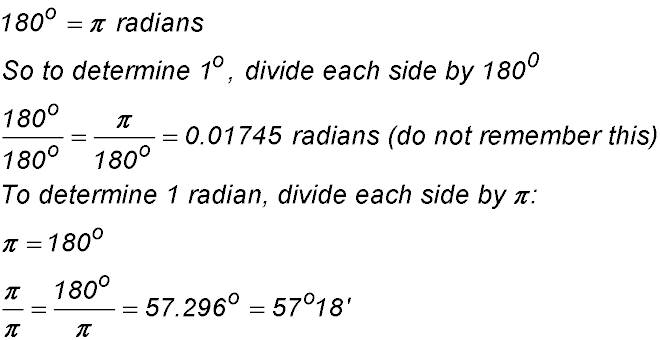Where the techniques of Maths
are explained in simple terms.
Trigonometry - Concept of radians.
Summary of video.
- Algebra & Number
- Calculus
- Financial Maths
- Functions & Quadratics
- Geometry
- Measurement
- Networks & Graphs
- Probability & Statistics
- Trigonometry
- Maths & beyond
- Index
Our measurement of angles to this stage has been in degrees. The number of degrees is a measure of how far we have turned around. Degrees therefore measure angular rotation.
In many situations, we need to ask questions about how far we move. Answers to such questions are unique and so bring the concept of functions into our consideration.
To measure distance, we change our perspective of an angle. Instead of looking at rotation, we start with an assessment of how far we move around the circumference of a circle.
With this view, the angle at the centre of a circle is measured in terms of the length of the arc defined by that size of angle around the circle.
If we move around a unit circle a distance equal to the radius of 1, we then say the angle at the centre is 1. We give that angle the name radian.
If we move around the unit circle a distance equal to 2 radii (the curved distance equal to the diameter), then the angle formed at the centre is 2 radians.
Check out the great diagram showing radians from Wikipedia by clicking here.
So a radian facilitates the measurement of distance in contrast to an angle which measures rotation.
Given the above statement of the relationship between arc length and radian as a definition of the size of the angle, we can write

As the angle (now measured in radians) is determined by the ratio of two lengths, it is a non-dimensional value.
Calculating radians and degrees.
In a unit circle, the circumference is 2π centimetres (or some other unit of length). Hence the angle at the centre of a circle is 2π radians.
The angular rotation is 360°.
So 2π radians is equivalent to 360°
∴ π radians is equivalent to 180°
That then provides the basis for converting angles to degrees and vice versa.

Use this approach for doing all conversions either way. DO NOT try to remember the fraction -
you will forget it in the exam.
Calculator use.
The latest calculators have a button to change between degrees and radians. If you have one of these and are allowed to use it in exams - GREAT!!
Older calculators require about 3 steps to change from one form to the other. Most students then forget (especially in exams) to change back to evaluate expressions including those used in sine and cosine rules.
If you have one of those calculators and do not wish to waste time changing from one settling to another, just use the conversion from radians to degrees and put that into your calculator. Some examples of that use are included in Radians - Test Yourself 1.
Other bits:
1. The radian is the unit included in the International System of Units for measuring angles.
2. We sometimes write a radian value followed by a superscript c - for example 1.5 radians is written as 1.5c. As this symbol is often confused with the degree sign, it is more common to ignore the letters although many people write rad after the number - for example 1.5 rad.
BEWARE FROM NOW ON IN TRIG CONTEXTS!!! An angle will always have a degree sign. If a number does not have a degree sign, it is a radian.
So tan(45°) = 1 BUT 